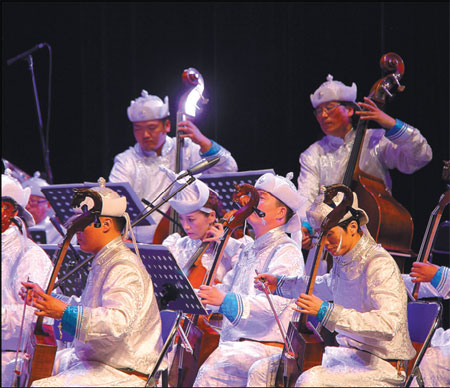Matouqin takes the lead in an orchestra with a difference
By Chen Nan (China Daily)
Updated: 2014-05-23
|
The Mongolian instrument matouqin is the focus of a symphony orchestra from the Inner Mongolia autonomous region. Provided to China Daily |
Few people knew about Uxin, the small banner in the Inner Mongolia autonomous region, before the matouqin symphony orchestra was created in May 2013. It was the country's first symphony orchestra featuring an instrument from an ethnic group.
Among Uxin's 130,000 residents, more than 10,000 play the matouqin, a traditional Mongolian bowed stringed instrument.
"(The number of players) proves the popularity of the instrument and how much we love it," says Chagan, the artistic director and co-founder of the symphony orchestra.
On May 28, under the baton of Chagan, 56 members of the orchestra, including 37 matouqin players, will perform at the National Center for the Performing Arts in Beijing.
The repertoire includes traditional Inner Mongolian folk music, such as Pastoral Song and The Horse's Back, to classical symphonic works, including Carmen Overture and Czardas.
The composer also rearranged folk songs from Northwest China, including Shan Dan Dan Hua Kai Hong Yan Yan (Red Morningstar Lilies Are In Blossom), for the matouqin, presenting a fresh take on the capabilities of the instrument.
The matouqin, or morinkhuur, aka the horse-head fiddle, is possibly the most important musical instrument of the Mongolian ethnic group, which originated from the nomadic people during the Tang Dynasty (AD 618-907).
For people of the Mongolia ethnic group, like Chagan, the matouqin represents the people. It has long been a dream of the composer to bring the beautiful and deep sound of the instrument to a wider audience.
He loved going to weddings as a child with his mother - a singer and musician.
"She would sing and perform for three days with a small band without repeating a song," recalls Chagan. "No matter what they performed, the matouqin was always part of it."
Chagan started studying Western instruments, such as the oboe and piano, but he was still recruited into the Singing and Dancing Troupe of Erdos City. Chagan says the matouqin is his favorite instrument.
"The matouqin is a magical instrument with a profound history, which deserves to be known by more people. Though it has just two strings, it can produce a wide range of sounds," Chagan says.
He has been devoted to exploring many more possibilities for the instrument. About five years ago, he was given a chance to realize his dream when he was approached by the local government to found a troupe. "We want to break the conventional impression about the matouqin and give it a new life."
When he came up with the idea of creating a symphony orchestra, the other musicians doubted his plan - combining the two different cultures seemed odd to them.
After three years of preparation and experimentation, the Matouqin Symphony Orchestra of Uxin Banner was born in 2013. It features musicians with an average age of 26.
For Chagan, who is now based in Beijing and has composed for more than 40 films and TV series, the most challenging part was re-arranging Western classical music and finding instrument makers to produce the matouqin of different sounds.
"We want the instrument to be taken to an international audience, but the core is to keep the root of our culture and focus on the matouqin," he says.
Over the past 18 months, around 25 original works have been written by Chagan and other Inner Mongolian composers, mostly reflecting on the lives and people of the Mongolian ethnic group.
Instead of wearing traditional colorful Mongolian clothes, the musicians of the orchestra wear black tuxedos and long white robes of Inner Mongolia, because Chagan says they are more appropriate for a symphony.
Yilatu, director of the Matouqin Symphony Orchestra of Uxin Banner, says the orchestra made its debut performance in Uxin banner, and received warm feedback from the audience.
"They were curious to see the orchestra and they have never listened to the matouqin performed in that way," he says.
"We believe the matouqin came from ordinary families and local people so their opinions are very important," the director says.
IF YOU GO
7:30 pm, May 28. National Center for the Performing Arts, 2 West Chang'an Avenue, Xicheng district, Beijing. 010-6655-0000.
chennan@chinadaily.com.cn

High-speed train debuts in Inner Mongolia
A bullet train departed Hohhot East Railway Station for Ulanqab marking the start of high-speed rail services using Inner Mongolia’s first newly-laid high-speed railway on Aug 3.

